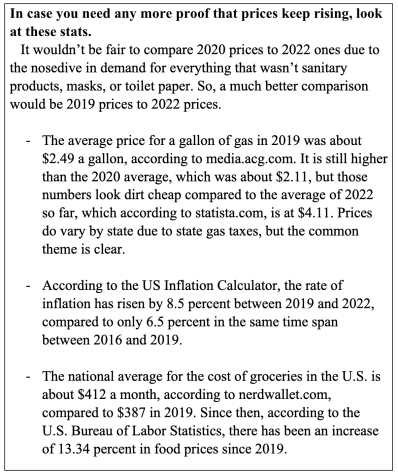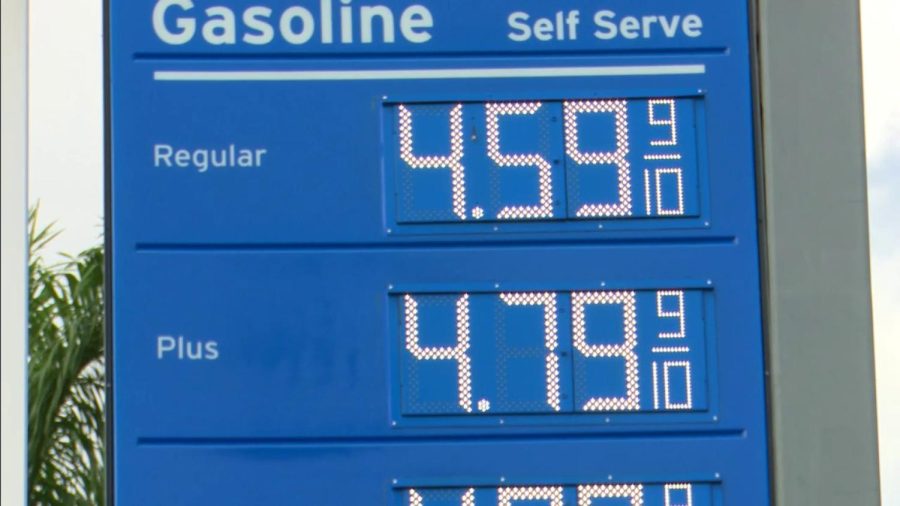Stagflation: The 70’s All Over Again
For all of us in the states, this is a sight we now have to deal with every single day, whether it be from passing by it and getting more fed up with the never-ending increase, or even worse – realizing it’s the time you’ll have to dump that amount of money into the bottomless pit that the pumps are. Source Link: local10/news/florida/2021/10/11/florida-gas-prices-surge-to-their-highest-in-years/
May 4, 2022
Ah yes, the Seventies: a forgettable yet unforgettable decade. A decade of disco, kitsch, brown on everything, and bizarre fashion choices. It has been over forty years since that decade ended, yet there are many parallels we can make with that decade to our own: the 2020s. Bell-bottom pants, a performance car craze, the end of an unpopular war, and the transition from having a corrupt idiot in the White House to another even more corrupt idiot.
But there’s also skyrocketing fuel prices, rising inflation, and an overheated market. We can see the effects of policies made by both Biden and his administration, as well as by those who came before him, who had a warped understanding of how economics work and on how to save the planet, with selfish corporate interests at play too. Many aren’t familiar with the reasons why all this is happening. Many are quick to deny it, accept everything as it’s going, or pin it all down on Old Joe. While the latter is close, as with everything, it is all a lot more complicated than it seems.
Reason 1: Less Supply of Goods
People are finding it much more expensive to buy things like food, water, cars, appliances, tech, and other goods compared to just one year ago. That is because the global supply chains are in an absolute mess right now. See, when the COVID-19 pandemic began over two years ago, it caused mass panic in the world’s markets, both by consumers and corporations.
People rushed to supermarkets to hoard food and water, as well as supplies from department stores. They almost completely stopped buying commodities, such as electronics. Many people lost their jobs in the initial phase of the pandemic, leading to them saving money only for what they needed. And in response to that sharp decline in demand, companies scaled back production of almost everything. Factories that manufactured phones, computers, cars, and appliances shut down or made cuts in production, as corporations didn’t wish to lose any money, along with COVID-19 concerns in the factories.
But by late 2020 and early 2021, demand for those commodities began to go back to normal, with the economy having rebounded from the panic that had shaken it. People wanted to splurge a bit, mostly using the money from their stimulus checks. In some cases, the demand was even stronger than before the pandemic. That spike caused existing inventories to run empty, which required more production. However, the factories couldn’t keep up with that demand. Suddenly, there was an international parts and labor shortage, both in factories and the supply chains. At the top, there is a shortage of components to make those products, such as microchips and batteries, as the companies who make them also made cuts in production. And at the bottom, there is a shortage of labor in the distribution network. There’s currently a shortage of shipyard workers, truck drivers, and retail workers.
The impact is even stronger here in the U.S., as most of our goods must be imported by ship from factories in China and Southeast Asia or driven in by trucks from ones in Mexico and Canada. In China, cases never really went down as they did in the West, and so most of the country is still under strict lockdowns and curfews, meaning that companies cannot operate. That is causing shortages of many products globally. And this goes to show how much we rely on foreign countries, especially China, for our goods and how much of a mistake it was to hand over most of our industrial capability to our biggest enemy. Many companies are now beginning to move some of their production from China to places like Mexico, where Mexican labor is also becoming cheaper than Chinese labor. If production is shifted to Mexico, one of our neighbors and closest allies, the U.S. won’t have to deal with a hostile Chinese government for trade. Not to mention, it’ll save companies a lot of money in shipping costs due to its much closer location and partially solve our shortages. However, that takes time, as it isn’t really process that can be done in a couple of weeks or months.
The process of transferring all that industry by setting up bureaucracy, supply chains, building and setting up plants, hiring workers for those plants, training those workers, and the preparation of raw materials for production takes years to complete. Even then, that doesn’t solve the labor shortage in the transit and distribution process. The reason for that is simply that the pay that they are offered isn’t enough to cover most of their expenses. Even necessities like food and water, in which supply isn’t a problem, are seeing rising prices because less of them are arriving on store shelves, as workers aren’t going to work if they can’t afford them anyway. It’s a never-ending cycle.
Reason 2: Overprinting of Money
As I touched on earlier, people don’t want to work because their salaries cannot keep up with the rising costs of pretty much everything. The minimum wage has not kept up with inflation, with the federal minimum wage being only $7.25 – a number that has not changed since 2009. The buying power of the average American has been declining since 1973, all while the cost of living keeps increasing and wealth inequality reaches an all-time high. On the surface, looking at a graph of the U.S.’s GDP (gross domestic product) makes it look as if the U.S. has never stopped growing and becoming richer. But, looking at other graphs of the average buying power of Americans and of salaries compared to the cost of living will tell you a very different story.
Another factor is that many people realized how disposable they were to big corporations as they were laid off in mass during the early stage of the pandemic. Many found out ways to make good money through online or independent jobs, such as Uber or Doordash drivers. These jobs were able to sustain them or at least give them a bit of money on the side but came with the added benefit of independence from any bosses or supervisors. But this all worsens the labor shortage and prices. But there is a much bigger reason for this mess, and it’s that the money you’re paying for what you buy has lost a huge part of its value. The Federal Reserve has printed over 80 percent of all dollar bills currently in circulation. Since more dollars are in existence, it drives the value of the currency down and it take more of the same currency to buy the same products. It isn’t only affecting us Americans, as other countries are going through their own rounds of inflation or are directly suffering the effects of our inflation, as with currencies that are latched onto the standard of the dollar, like the Canadian dollar.
This exact thing happened back in the 70s, in which more money was printed, salaries began to stagnate, and prices rose in the aftermath of two oil embargos and a bunch of other key events. We are currently seeing the highest levels of inflation since 1982, the peak of the 70s recession. The reason why so much money is being printed is also due to an oil shortage, since when oil prices go up, the value of the dollar goes down. While steps have been made to relieve the situation, such as raising interest rates so people are less likely to take out loans that they may not pay back to avoid having banks collapsing. However, its going to take a lot more than that to stop this inflation. Yet, there is another, perhaps the biggest factor in all this that is ruining every effort to reduce inflation, which are the aforementioned oil prices.
Reason 3: Less Supply of Oil
Many on the right-leaning side of politics love to blame the skyrocketing fuel prices and inflation (since the price of oil is tied to the value of the dollar) fully on Biden while claiming that Trump was the one who gave Americans some of the lowest fuel prices and inflation levels since the 1990s. While Biden does have a hand in those insane prices, he wasn’t the cause of them, just as Trump wasn’t the cause of cheap gas prices in his term. Because with all things economic, it’s a lot more complicated.
Since 2015, oil prices had been declining since reaching highs in 2013 and 2014, mostly caused by instability in the Middle East by ISIS’s war and the Arab Spring and subsequent conflicts, as well as Russia’s invasion of Crimea. With the defeat of ISIS and the end of the Arab Spring, oil prices plummeted. The deregulations of the domestic oil industry during Trump’s presidency further lowered the prices. Trump did this to help a burgeoning domestic oil industry to not only provide jobs for Americans but also eliminate our reliance on Middle Eastern oil. Another thing that happened was a boom in fracking, which is a technique that involves using hydraulic pressure to drill deeper into the Earth than conventional oil wells, allowing for access to more oil. Oil-rich states like Alaska and Texas showed a lot of promise.
Then, oil prices fell further at the start of the pandemic when demand for fuel went down, as people were stuck at home. With that sharp nosedive in demand, oil companies drastically reduced the production and refining of crude oil. While it ensured that profits weren’t lost, it severely reduced the amount of drilled and refined of oil in existence around the world. And as with other commodities, when demand resurged in 2021, it caused a mess. Oil prices are now reaching new highs, but what makes it worse are the new regulations placed on the oil industry.
When Biden came into office, one of the first things he did was revoking the construction permit of a new pipeline that promised to connect Texan and Canadian oil fields, which was the Keystone XL pipeline. Fracking came under huge scrutiny under his administration, who banned it on federal land as part of his environmental policies to stop pollution caused by it and switch to green energy. Contrary to what his administration and the mainstream media says, the hacks on oil refineries and Russia’s invasion of Ukraine didn’t cause or add much to the problem here in the U.S. Oil prices were already high, and the only place that really felt the impact of the war was Europe, who relied mostly on Russian oil and gas for energy and fuel. So, the U.S. cannot make enough oil for itself anymore, but it also can’t import its oil because of the shortage of workers in the supply chain.
My Opinions
These are all problems that are causing us all headaches now, with the only ones benefitting from all this being the wealthy and powerful investors and company executives who are seeing the returns on their investments skyrocketing from inflation and oil profits. This is not a sustainable growth, as we’ve seen many times in the past – whether in 1929, 1973, 1987, 2000, or 2008. These were all periods in which companies were reporting record profits. But what goes up always comes down, with the higher it goes the harder it tanks. The good thing is that these problems are very much solvable. First is inflation. Much against what many call for, inflation must not be reversed, as it would risk deflation – a much worse risk that may collapse the global economy. If you raise salaries as well, you risk companies raising prices for everything, worsening the situation. So, what must be done is that interest rates must be raised further and that salaries must be raised, but with a twist. To prevent companies from raising prices, the government must allow them room to keep prices the same while raising salaries by removing bottom-end costs, such as by giving out tax cuts. And the latter cannot be a one-time event. A law needs to be passed that ensures that as inflation rises, salaries on a national level must rise along with it, and appropriate tax cuts must be given.
Another thing that needs to be done is that money printing must be reduced to the bare minimum needed to keep the economy afloat. All that will bring an end to our current economic woes and ensure a stable economy in the long run. This will lower oil prices as well, but to bring them back to pre-2021 prices, the ban on fracking must go and the Keystone XL pipeline’s permit must be returned. I’m aware of the environmental impact that decision will have, and I do know that those regulations had good goals in mind. But it ignores that the U.S., along with the entire world, simply isn’t ready to go green yet. We don’t have enough wind fields, solar panel fields, geothermal or hydroelectric power plants yet to fully eliminate our need for fossil fuels. Not to mention, they are still nowhere near as efficient, cheap, or powerful as fossil fuels. Not everyone can afford green energy, solar panels, or green products, such as Tesla cars. Even then, even if the U.S. and Europe go net-zero, countries like China and Russia – two of the biggest polluters – will ruin any progress toward stopping climate change. It will reduce carbon emissions, but it truly needs to count on all the biggest world powers to join in for it to be effective. Third-world countries should be exempted from this to allow them to industrialize first and then make them switch to green energy.
But I really doubt that our two biggest enemies will be willing to sit down and cooperate, as it will force them to regulate or give up the industries that built their modern societies – a price neither will be willing to pay. We must still continue doing our part by improving and developing our green energy until it actually can replace fossil fuels, as well as fund more research and allow for the construction of nuclear power plants, as newer technology has already made it a far safer, cleaner and more powerful energy source than it was 40 years ago. In the meantime, they can serve as complimentary sources to fossil fuels as they are phased out. And those are just the facts.






